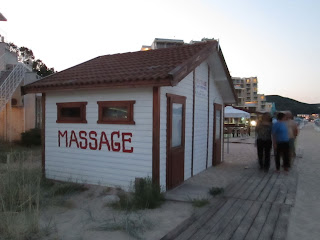 |
| The exhibition catalogue. |
One summer morning fifty years ago the whole Macedonian capital city of Skopje was woken up by a massive earthquake. It was 5.17 AM; many people, panicking, ran to the streets still in their bed clothes, leaving their homes and belongings behind. Nearly 80 percent of the city was destroyed beyond repair as a result of the catastrophe, including many valuable historical buildings.
The earthquake itself took less than a minute but the imprint it left in the psyche and lives of the local people has been long-lasting. Over a thousand people were killed; a few thousands were injured. Stories from the day of the earthquake and afterwards are still alive in the city's folklore.
To commemorate the 26 July 1963 earthquake, a temporary exhibition was opened earlier this year at the
Skopje City Museum. It displays artifacts, photographs, newspaper clippings, maps, videos - all related to the catastrophic event.
The building that now houses the museum in 1963 was Skopje's train station. It too was heavily damaged during the catastrophe. The hands of the clock on the outside wall of the building stopped at the time of the earthquake, and have not been moved since.
Inside, besides the temporary earthquake-dedicated exhibition, one can see seismographs on display (try to stamp your feet on the floor a bit heavier and you will see a mini 'earthquake' made by yourself). There are also a few recreations of after-earthquake premises: a destroyed 1960s kitchen, a hospital tent, street signs of a tent city (yes, for a couple of months following the event Skopje's population indeed lived in tents).
The museum itself, of course, is interesting to visit not just because of this exhibition. Downstairs, there is a concise but valuable exhibition of historical artifacts related to the history of Skopje (some of them several thousand years old), and the temporary exhibitions are always changing. The institution won the local 'museum of the year' title in 2012.
Going back to the earthquake topic, an interesting thing to keep in mind is that the catastrophe happened during the Cold War. Macedonia back then was part of the socialist Yugoslavia.
The catastrophe, in a way, was an ice-breaking event between the Eastern Bloc and the West. Both the socialist and the capitalist countries sent aid to Skopje and helped the Macedonians to rebuild their capital city (for this reason today in Skopje we see many streets named after various countries and cities - in order to honour the support and help they provided to Macedonia). Although much of the help was genuine, one could also see a certain competition of helpfulness (who are better and more generous: the East or the West? the socialists or the capitalists?).
Although officially socialist, the former Yugoslavia was, perhaps, one of the countries that had the least enemies back in the day. For example, the Yugoslavian passport was a valuable document that enabled its owner to travel to nearly every country around the world (as opposed to ID documents of USA, USSR, and their 'friendly republics'' that only enabled free travel within their own ideological camps). When the great earthquake happened in Skopje during the Cold War, cynically as it sounds, it was a uniting event where many people could for a while forget about their ideologies and simply be humans.
 |
| The picture of the famous clock on the outside wall of the present Skopje City Museum; its hands have not moved since 1963. |
Text and photos (c) Agne Drumelyte, 2013.




























